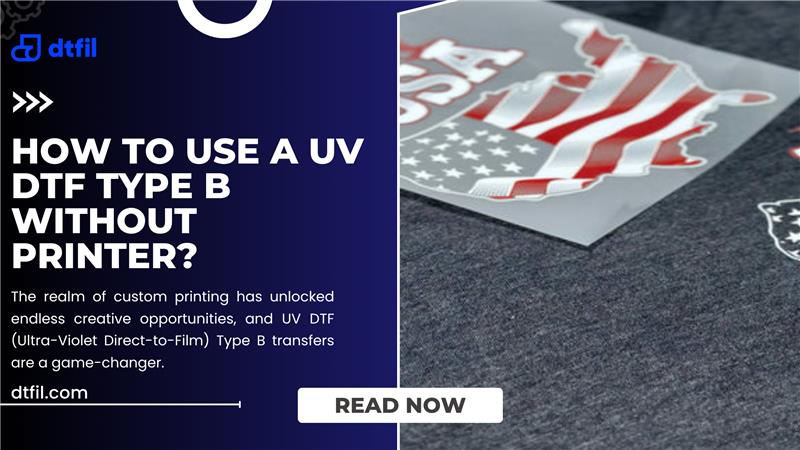Ever tried baking a cake with salt instead of sugar? It looks like a cake until you take that first bite and instantly regret your life choices. That’s kind of what happens when you try DTF transfer with regular printer ink, the idea might seem harmless at first, but the results? Not exactly sweet.
As DTF printing continues to gain popularity among crafters, entrepreneurs, and DIY apparel enthusiasts, many are wondering if they can skip a few steps by using a standard inkjet printer and everyday ink for DTF transfers.
But before you load up that glossy DTF transfer printer film and hit “print,” let’s talk about what really happens when you mix the wrong ingredients in this creative recipe. In this blog, we’ll explore how DTF printing actually works, compare ink types, and guide you toward the right tools for high-quality results, so you don’t end up regretting your next project.
What Is DTF Printing and How Does It Work?
DTF printing—short for Direct-to-Film—is quickly becoming a favorite method for customising t-shirts, hoodies, and all sorts of fabric goods. It’s a pretty cool process: you print your design onto a special PET film, often called DTF transfer sheets, using a printer that’s built or modified specifically for this job.
Once the design is on the film, you sprinkle a fine powder adhesive over the wet ink, let it cure with heat, and then press it onto your fabric using a heat press. That’s how you transfer the design from film to fabric, and the final result? Crisp, colourful artwork that holds up well through washes and wear.
Now, if you’re thinking about trying a DTF transfer with regular printer ink, here’s a reality check: it doesn’t work like that. While it might be tempting to grab your everyday inkjet printer and see what happens, DTF transfers require specialized ink that’s designed to bond with the adhesive and withstand heat.
Regular ink just isn’t built for this. It won’t stick properly to the film, and the design is likely to smear, fade, or peel right off. If you're serious about creating high quality designs, whether for personal use or to sell, you’ll want to invest in the right gear and use proper materials for custom print DTF transfers.
What Kind of Ink Does DTF Printing Require?

DTF transfer process require special inks—DTF ink, not the type of ink you print with daily. DTF inks are thicker and more durable inks. DTF inks are made to bond with PET film and also with the adhesive powder at the time of heat application.
You might be reading this wondering if you can try a DTF hack using an inkjet printer or try a DTF transfer with regular printer inks.
Many people have done this first before learning about DTF printing, and although it might feel like a viable option, it's just going to lead you to a frustrating experience. Standard ink just cannot take on the heat and also the bond of the design itself, causing the design to typically smudge, peel and/or fade.
Here are the reasons why DTF inks will be preferred:
1. Great color vibrancy
2. Better adhering in the heat pressing stage
3. Longer-lasting/washable print quality
If you are seeking bold, professional results, do not skip taking a shortcuts in the process, and use the correct inks.
Difference Between DTF Ink and Regular Ink
If you're trying to decide between using DTF ink or standard ink for printing, it's important to know how different they really are. While both may go into a printer, only one is designed to transfer the design properly during the DTF transfer process.
Using DTF transfer with regular printer ink might sound like a cheap shortcut, but it usually ends in disappointment. Regular ink simply isn’t made to withstand high heat or bond with adhesive powder—two things that are essential in DTF printing.
Here’s a quick breakdown of the key differences:
-
DTF Ink: Designed to work with PET film and adhesive to transfer the design cleanly onto fabric.
-
Regular Ink: Made for paper printing, not suitable for film or fabric transfer processes.
-
DTF Ink: Can withstand high temperatures during the heat press step without smudging.
-
Regular Ink: Often fades, smears, or breaks down when exposed to high heat.
-
DTF Ink: Produces vibrant, washable prints perfect for custom print DTF transfers.
-
Regular Ink: Not durable enough for clothing or repeated washing.
If you want the best ink for DTF transfers, stick to real DTF ink—it’s the only way to get strong, lasting results that look and feel professional.
Also read: DTF Transfer Printing vs Other Methods: DTG, Screen Printing, and Sublimation
Can I use regular ink for DTF transfer printing?
No, you cannot use regular ink for DTF transfer printing. DTF printing requires special pigment-based inks that are designed to work with the entire transfer process. If you’re planning to make custom print DTF transfers, using regular ink will result in poor adhesion, dull colors, and prints that don’t last.
A diy DTF printer uses DTF ink to print on a transfer film, which is then coated with adhesive powder and applied to fabric using a heat press. Regular ink can’t bond properly during this process and won’t withstand high heat or washing.
To get strong, vibrant direct to fabric transfers and reliable print quality, always use the proper DTF ink. This ensures your designs transfer the design cleanly and stay durable on the fabric.
How to Replace Regular Ink with DTF Ink in a Printer?

If you're trying to achieve a DTF transfer with regular printer ink, you may be disappointed with the outcome. Regular ink is not compatible with DTF technology and won’t provide the durability, color, or bonding needed for high-quality transfers. To get proper DTF printing results, you’ll need to switch to DTF-specific ink. Here’s how to safely replace regular ink with DTF ink in your printer:
Step-by-Step Process to Replace Regular Ink with DTF Ink
-
Choose a compatible printer
Not all printers can be used for DTF. Make sure you're working with a converted inkjet or a purpose-built DTF transfer printer. Popular DTF printers often start with Epson base models.
-
Remove all regular ink
-
Remove the existing ink cartridges from your printer.
-
Clean out any remaining ink from the ink lines and printhead using a cleaning solution. This step is critical to avoid mixing ink and DTF ink, which can clog the printer and affect the print quality.
-
-
Install DTF ink
-
Insert your new DTF cartridges filled with DTF ink.
-
Run a few cleaning cycles to ensure the new ink flows properly through the system.
-
-
Prepare your artwork and settings
-
Use RIP software to manage printing the design with the correct color profiles and ink flow.
-
Print your design onto DTF transfer sheets (also known as transfer film).
-
-
Apply adhesive powder and heat press
-
After printing onto the film, apply hot-melt powder to the wet ink.
-
Cure it using a dryer or under a heat press to prepare it for application.
-
-
Transfer the design to fabric
- Position the film on your fabric and use a heat press to transfer the design.
- Use the recommended temperature and pressure to ensure the print will withstand high heat and repeated washes.
Conclusion
While it might seem convenient to try a DTF transfer with regular printer ink, the reality is that regular ink simply doesn’t meet the requirements of the DTF process. From poor adhesion to low durability, the results will fall short of the vibrant, long-lasting prints made possible with proper DTF ink.
At DTFIL, we understand that custom print DTF transfers are more than just printing—they're about precision, consistency, and quality. That’s why we provide premium products and expert support to help you succeed, whether you're a hobbyist or scaling a print business.
Ready to improve your DTF printing results? Visit us now to explore top-quality DTF printers, inks, and transfer films where professional printing begins.
FAQs
Can you print DTF with regular ink?
No, DTF transfer with regular printer ink won't work. Regular ink can't bond with transfer film or withstand high heat during pressing, causing poor print quality.
Can you use regular printer ink for heat transfer?
Using regular printer ink for heat press transfers won’t give lasting results. It lacks the bonding strength and durability needed for dtf transfers or fabric use.
Do you need special ink for DTF?
Yes, DTF printers require DTF ink, not regular ink. Special ink ensures proper printing the design, bonding to transfer film, and resisting heat and wash cycles.
What type of ink is used for DTF transfers?
DTF transfers use pigment-based DTF ink formulated for use on dtf transfer sheets. It’s designed to transfer the design clearly and withstand high temperatures.
Read more related blogs: 
What is DTF Powder? Know its Benefits, Types, & Usage








